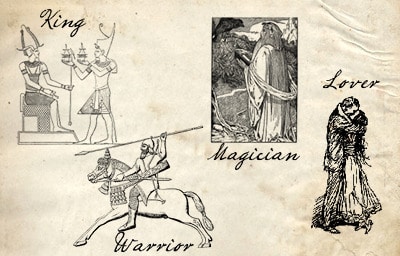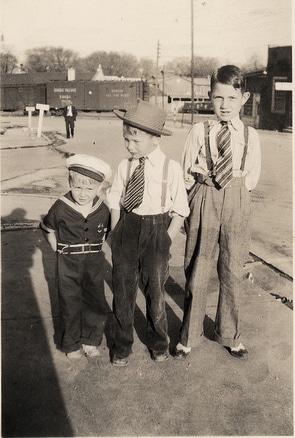
The purpose of the Art of Manliness is to help men become better men. To that end, we often explore some of the problems unique to modern men and offer suggestions on actions they can take to overcome those problems. One problem that we discuss regularly on the site is that of the modern male malaise. Maybe you’ve experienced it: You feel restless and without a sense of purpose. You lack confidence in yourself as a man. You might be 20 or 30 or 40 years old, but you don’t feel like you’ve reached manhood.
A few weeks ago, we did a series called “The Five Switches of Manliness.” In it we made the case that within every man are psychological “switches” that must be turned on if a man wishes to activate his unique primordial masculine energy. The switches are how you power up the Wild Man within you and overcome the feelings of shiftlessness and male malaise that many men experience these days.
Another way of approaching the cure for the modern male malaise comes from the book King, Warrior, Magician, Lover: Rediscovering the Archetypes of the Mature Masculine, by Jungian psychologist Robert Moore and mythologist Douglas Gillette. Moore argues that masculinity is made up of four archetypal male energies which serve different purposes. All men, whether born in the U.S. or Africa, are born with these archetypal energies. The authors argue that to become a complete man, a man must work to develop all four archetypes. The result of striving to become complete is a feeling of manly confidence and purpose.
King, Warrior, Magician, Lover was originally published in 1990, and it has had a pretty big influence on masculinity in America. It, along with Robert Bly’s book, Iron John: A Book About Men, kick-started the mythopoetic men’s movement of the early 1990s. During this time, many men in America started attending men’s groups and weekend retreats where they would take part in rites of passage and discuss ancient myths to gain personal insights about what it means to be a man. You can still see the influence of King, Warrior, Magician, Lover in books like Wild at Heart or weekend men’s retreats like The ManKind Project.
Some of the ideas in KWML are of the New-Agey, sensitive pony-tail guy, sitting in drum circles in the woods type. Personally, that sort of approach doen’t appeal to me as a man. I know lots of men that get a lot out of that sort of thing. To each their own. Nonetheless, I still feel like I benefited a great deal from reading the book and putting into practice some of Moore and Gillette’s ideas.
Over the next few months, we’re going to be delving into the four masculine archetypes in KWML. We’ll explore what they are and how you can access them on your journey to becoming a better man.
A Short Primer on Jungian Psychology

Psychologist Carl Jung
Like much of the literature in the mythopoetic men’s movement, KWML is grounded in the psychology of Carl Jung, particularly in his idea of psychological archetypes. To understand the four archetypes of masculinity, it’s helpful to understand a bit about Jungian psychology. I could devote an entire post to Jung’s psychology, but I’ll keep this brief for our purposes.
Carl Jung was one of the early and most influential modern psychologists. Ever take one of those Myers-Briggs type indicator tests? Those were inspired by Jung’s idea of extroverted and introverted personalities. Have you ever heard somebody talk about the “collective unconscious?” That’s Jung, too.
From 1907 to 1913, Jung closely worked with and studied under the the Father of Modern Psychology, Sigmund Freud. While the two shared many of the same ideas about the human mind, they had their differences. Jung agreed with Freud’s theory of the unconscious mind, but he thought Freud’s view was too negative and incomplete. Freud focused on the unconscious as the place in which people harbored and repressed negative emotions and deviant thoughts. Jung agreed that negative emotions were repressed in the unconscious, but he also felt that positive experiences, thoughts, and emotions could be held in the unconscious, too.
Jung also diverged from Freud’s theory of the unconscious by arguing that there was a second, even deeper unconscious mind existing in all human beings. Jung called the first level of unconscious (the one Freud also affirmed) the “personal unconscious.” The personal unconscious was created by personal experience.
The second level of the unconscious mind Jung called the “collective unconscious.” According to Jung, the collective unconscious consists of instinctual and universal thought patterns that humans developed over thousands of years of evolution. Jung called these primordial behavior blueprints “archetypes.” For Jung, archetypes form the foundation of all personal experience. It doesn’t matter whether you’re a sophisticated businessman living in a high-rise apartment in Manhattan or a bushman living in a hut in Africa; Jung would argue that no matter who you are, you have the same archetypal behaviors embedded within you.
Jung believed that these archetypes of human behavior came to the surface in the conscious mind through symbols, rituals, and myths. He argued these archetypical patterns explain why we see similar motifs and symbols in rituals and mythical stories across cultures. For example, the dying/resurrecting God figure can be found in the stories and myths of ancient Greeks, ancient Sumerians, Christians, and Native Americans.
Jung’s belief that the collective unconscious is reflected though symbols and ritual also likely explains his fascination with the mystical and esoteric. He was a serious student of fields like alchemy, astrology, dream interpretation, and tarot, although not for their claimed ability to tell the future or to turn lead into gold. Rather, he explored these esoteric traditions because he believed they could help individuals tap into the collective unconscious and explore the archetypal behaviors that resided within.
Alright, so what are the archetypes that Jung believed existed in each person? While Jung suggested a number of universal archetypes, the four main ones are: the Self, the Shadow, the Animus and Anima, and the Persona. For the purpose of this article, I’m not going to go into detail on all four of these. If it’s something you’re interested in, I’d encourage you to investigate these archetypes on your own.
Before we move on, let’s be clear about something. Archetypes aren’t personality types. Jung didn’t think you could classify a person as a specific archetype. A man can’t take a test to tell him that he’s a “Shadow.” Rather, the archetypes are simply patterns of behavior and thought, or “energies” that can be found in all people in varying degrees.
The Four Archetypes of the Mature Masculine: King, Warrior, Magician, Lover
Psychologist Robert Moore took the concept of Jung’s archetypes and used it to create a framework that explained the development of mature and integral masculinity in men. Moore argued that the problems we see with men today–violence, shiftlessness, aloofness–are a result of modern men not adequately exploring or being in touch with the primal, masculine archetypes that reside within them. Like Jung, Moore believed that men and women possess both feminine and masculine archetypal patterns–this is the anima (feminine) and animus (masculine).
The problem with modern men is that Western society suppresses the animus or masculine archetype within them and instead encourages men to get in touch with their “softer side” or their anima. Moore would argue that there’s nothing wrong with men developing those softer, more nurturing and feminine behaviors. In fact, he would encourage it. A problem only arises when the development of the feminine comes at the expense of the masculine.
According to Moore, masculine psychology is made up of four major archetypes: King, Warrior, Magician, and Lover. In order for a man to achieve mature masculine strength and energy, he must be in touch with all four.
The Structure of the Archetypes
Moore argues that each male archetype consists of three parts: the full and highest expression of the archetype and two bi-polar dysfunctional shadows of the archetype. To better understand this, Moore portrays each archetype as a triangle. Here’s an example of the King archetype thusly illustrated:

The King Archetype
The bottom corners of the triangle represent the bi-polar shadow-split in the archetypal Self. The goal of each man, according to Moore, is to reconcile and integrate these two bi-polar shadows in order to attain the fullest expression of the archetype as represented at the top of the triangle.
Moreover, each archetype has a mature and immature form. Moore calls the mature forms of the masculine archetypes “Man Psychology” and the immature forms “Boy Psychology.” The mature masculine archetypes are the four we’ve already mentioned: King, Warrior, Magician, Lover. The immature, boyhood archetypes are the Divine Child, the Hero, the Precocious Child, and the Oedipal Child. Each of these immature archetypes have the same tripartite configuration as the mature archetypes. They all have their highest and fullest expression along with their two bi-polar dysfunctional shadows.
Before a boy can access the King archetype he must develop the Divine Child; before he can access the Warrior archetype, he must develop the Hero archetype. And so on and so forth.
Whew. That’s a lot to chew on and digest. It sounds complicated, but I think if you see Moore’s idea of the four masculine archetypes and the development from immature to mature masculinity in a diagram, it’s actually pretty easy to understand (Click the image to zoom in):
Over the next few months, we’ll be taking a look at each of the four archetypes and providing suggestions on how you can develop them more fully in your own life. Here’s a roadmap of what we have coming ahead:
- Boyhood Archetypes
- The King Archetype
- The Warrior Archetype
- The Magician Archetype
- The Lover Archetype
- How to Access the Archetypes
While being a man ultimately comes down to outwardly putting right principles into real action, those actions must come from a mature and healthy inner place, and these ideas, when thoughtfully reflected upon, can help get you pointed in the right direction as you seek to become the best man you can be.
I’d recommend getting a copy of the book so you can follow along as we go through the archetypes, as it will let you get more in-depth if your curiosity is piqued. Plus, I’d love to hear the insights you’ve gleaned while reading.
The Four Archetypes of the Mature Masculine:
Introduction
The Boyhood Archetypes – Part I
The Boyhood Archetypes – Part II
The Lover
The Warrior
The Magician
The King








